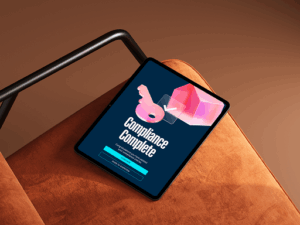In this first post of our digital property market series, we explore what a truly digital property market would look and feel like. Paying close attention to what components are necessary for an end-to-end digital transaction to occur, and how you create a unified, seamless journey and experience for businesses and consumers.
There’s no two ways about it, the property market is fragmented.
In a bygone age property transactions were much simpler and efficient. Physical cash, deeds, and contracts were exchanged in person as property changed hands in a fraction of the time it does today. However simpler it may have been, this was never a scalable solution for our society, as a result we’ve seen pockets of technology brought in and adopted over decades to digitise individual areas of the transaction process.
While large swathes of the process are now digitised, it lacks integrated, unified digital capabilities that reflect the property market’s pivotal role in the wider property ecosystem. This entanglement of digital and analogue processes ultimately creates a disjointed and opaque transaction process, where buyers and sellers are the ones to suffer the most. Not only has the digitisation process made each transaction more complex, but it has also led to an increase in the duration and failure rate of property transactions. Buying or selling property is a far cry from a seamless digital experience.
In a truly digital property market, the property transaction would look very different. Both businesses and users would experience a unified journey where there would be no need to log in to separate systems, no need to re-identify or re-key information, or repeat the same processes with different parties, and there would be a single and common view of truth. This vision isn’t an impossibility, it’s achievable.
It’s not as simple as implementing more technology, or more software. It’s not digitisation for the sake of digitisation. It’s more holistic than that, more connected, more transformative. In order for an end-to-end digital transaction to occur the following technological, legal and process protocols are necessary.
Let’s look at what that will look like.
Open and accessible data
In a fully digital property market, all the data should be FAIR: Findable, Accessible, Interoperable, and Reusable. Which certainly isn’t the case today.
We currently have a situation where the property market is awash with data, however, very little of it is held in properly digital formats. Instead, Word documents and PDFs reign, trapping data that is neither findable nor accessible in static documents which are impossible to share with other parties without being emailed or given to the post office.
For the data that is held in a digital format it’s trapped in systems that aren’t connected. Some data is in the estate agent’s system, some is with the conveyancer, there’s even more data stuck with the broker, the surveyor, etc. It is not that no one already has the information, it is that the data is inoperable. And if anyone were to be so lucky as to get the data they need, it isn’t easily reusable, and will often need to be rekeyed and reuploaded to conform to the bespoke parameters of the system being used.
Buyers and sellers deserve to have a property market that operates seamlessly end-to-end, which can only be achieved with FAIR data. Similar to what the banking sector went through with open banking. There was once a time when it was impossible to share the data in your bank account with any other parties or applications, but now with open banking that very same data is findable, accessible and reusable across any application you give permission to. That’s what the digital property market will be like.
You can find out more about open and accessible data in our blog.
Tokenised money and titles
Money and titles in their current form are not as digital as they appear.
They are a far cry from transactions taking place with paper money or cheques in exchange for the property deed that was in your hand – when ownership was tangible and exchanging money was quick and easy. However, despite the shift to online banking, moving money is risky, complex, manual and prone to errors (we’ve all heard the horror stories of fraud taking place at the point of completion). And digitised deeds are digital only in name, trapped in siloed databases at HMLR, requiring significant manual processes for HMLR and buyers and sellers. The property market needs a more secure, easily transferable, and digital-first solution.
One of the suggested options to bring money and titles to a fully digital state is through tokenisation, whereby both money and property ownership can be represented as blockchain-based tokens in a completely digital format. Digital money and deeds in this format would revolutionise transactions, being completely programmable for money and deeds to exchange at any desired date or time. Encouragingly, there has been thrilling progress in developing tokenised money, with the Bank of England already providing the groundwork for a digital pound. In addition, HMLR continues to vocally commit to moving forward with research on tokenisation. Tokenised money and titles are coming, it’s just a matter of when.
You can find out more about tokenisation in our blog.
Digital identification – an end to the repetition
The current process of proving your identification during property transactions certainly leaves a lot to be desired.
In a world before digital identification providers, physical passports made identification straightforward and the authenticity of a wet ink signature was universally accepted. Yes, these would have taken place in-person and would have had to be repeated for each professional the consumer engaged with, but the process was uncomplicated.
As the market began to digitise and new digital identification technologies entered the process, there was a general ambition these would foster rapid efficiency gains. The technology existed whereby an ID check could be completed once, verified to the required standard and shared with the other professionals in the transactions. However, despite the initial optimism, we’ve happened upon a highly siloed and repetitive process where different digital ID providers work with different professionals meaning consumers still have to perform the same checks again and again and operate through a labyrinth of scanned documents. Furthermore, the process of digital identification doesn’t actually produce anything digital. In fact, it becomes a verified PDF and the information is trapped once again.
The technology already exists to overcome this. Biometric verifications become the new norm and digital identities that are fully interoperable and verifiable reduce the repetition almost overnight. All that is needed is the will to change.
You can find out more about identity verification in our blog.
Smart(er) contracts for transactions
When it comes to digital contracts, once again, we find ourselves treading water in a pseudo-digital sea.
Property contracts were once simple paper-based affairs. Conveyancers read the papers, confirmed everything was in order, signed on the dotted line, and there would conclude the property transaction.
As the world digitised we began to see the implementation of Word documents and PDFs. While these came with the promise of improving efficiency, as we have seen elsewhere in the property process, they have achieved the opposite. These digitised documents showed themselves to be susceptible to the same manual errors and omissions that their paper-based forebearers would have suffered. And you don’t need reminding of the time and effort that’s needed to update an erroneous printed contract – who hasn’t suffered at the hands of a PDF that isn’t correct and needs to be converted back into a word document first before being updated?
Smart contracts are the solution to this conundrum. These truly digital (not just digitised) versions of legal agreements hold the information as data, not words or images, and can be programmed to execute according to agreed conditions.
Running as a program on highly secure blockchain technology they are effectively self-executing, meaning things happen automatically when specific conditions are met. For instance, a smart contract could specify that at the point of completion, insurances are automatically triggered and an outstanding debit is cleared by the mortgage advance – a programmable contract. Every step from start to finish is documented and verified within the smart contract, which not only reduces human error but also helps to build trust and confidence in the process. Best of all, the Master of Rolls has already stated they are as valid in law as any other contract, meaning there is no barrier to their widespread adoption.
You can find out more about smart contracts in our blog.
Orchestration – the digital backbone
All these components mentioned so far, accessible data, digital identity and signatures, tokenised money and titles, and smart contracts are necessary for a digital property market, but they are not sufficient to create one. Delivered individually the result remains fragmented, with digital processes taking place in isolation of one another, or in walled gardens of connectivity, forcing siloes and reinforcing a lack of connection and interoperability. To create a truly digital property market including a unified transaction journey and experience you need one more element: orchestration.
Orchestration is the missing piece of the digital property market puzzle. A market-wide infrastructure and intelligent backbone that connects systems and orchestrates the exchange of data throughout the property market. Similar to how the telecommunications networks we know and use daily for the transfer of data and calls from one mobile device to another, orchestration efficiently coordinates the various tasks, activities, and events in a property transaction. It brings together the different business processes of parties involved into a seamless digital journey, achieved by connecting their systems and data through a shared digital interface.
In an orchestrated system, no one needs to prove who they are multiple times, as it knows they are the same person. Data is never duplicated, or inconsistent, as the orchestration layer ensures everyone is looking at the same common view of the truth. Finally, an orchestrated system understands the order things have happened in. Unlike a cat’s cradle of APIs, in an orchestrated system there is order between all the parties.
Orchestration, along with the components described above gives the property industry what it has lacked to date: an ability for every part, and every party to function in the same environment, in a common ecosystem. It is, with the other components, the solution to the problem of the broken property industry, and the only way to avoid us repeating and re-encountering the same problems we have today.
That’s why we at Coadjute, have developed and launched exactly such an orchestration network, and are now enabling for the first time the market to unite and operate in this new and truly digital way.
You can find out more about orchestration in our blog.
Making the digital property market a reality
The property market is too complex and important to change through a sudden revolution. Instead, it has been evolving step-by-step from physical interactions to the semi-digitised property transaction we have today. The change has been inconsistent, and at times, delivered little or no benefit. However, this does not mean there is no hope.
Where we now stand is on the brink of a powerful step-change in that evolution, as we move from the marginal benefits of digitisation to the huge opportunities represented by truly digital processes.
Once the necessary technological, legal and process components including open data, digital identity, tokenised money and titles, and smart contracts are in place, and all connected to interact seamlessly with one another through orchestration, the property transaction will be unrecognisably accelerated. We will then see the truly unified digital journey and experience the market has been striving towards for so long.
None of this is science fiction, it’s all possible today, and Coadjute are committed to enabling that future: a truly Digital Property Market. A market not run by a mass of PDFs and APIs under a banner of digitisation, but a market utilising open structured trusted data and technologies like blockchain to create a seamless, efficient, and trusted environment for property transactions to take place and complete. It’s a future that benefits us all.


